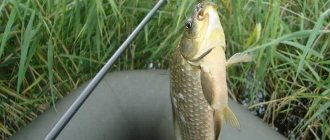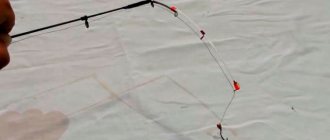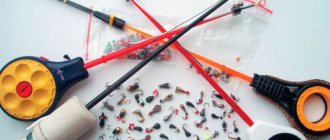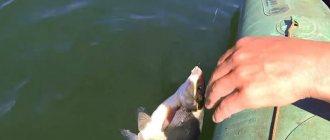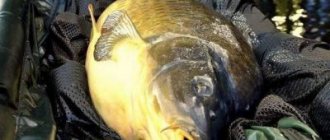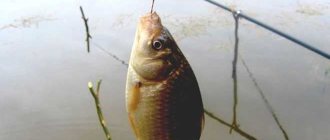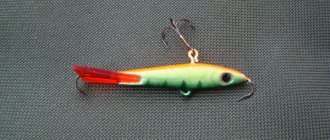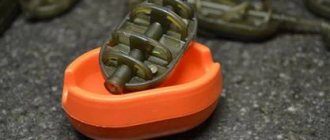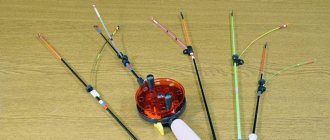Fishing with a summer jig with a side nod
A fishing rod with a side nod is one of the best ways to fish with a summer jig. This is quite a sporting way of fishing. Such tackle is allowed during the spring period, when both feeder and spinning rods are prohibited. In addition, with its help you can catch much more than with a regular float rod from the shore. A fishing rod with a side nod is catchy and so interesting that many people completely switch to it.
DIY side nod
Many people ask the question - how to make a nod with your own hands? Some people simply lack ideas, or some simple technical points seem incomprehensible. But it's not all that complicated. The material for the nod is inexpensive. Any springy one will do. But the easiest way is to take a regular plastic clamp. There are a dime a dozen of them around and they don’t cost anything. And depending on the length and thickness, we can make a nod with the desired level of sensitivity. Next we need copper wire. On average - from 0.5 to 1 mm2. It is required to make the middle ring and tulip. Now we tape the ring to the smooth side of the clamp with electrical tape. The nod will be springy. If you want more strength, take superglue. It definitely won't get any worse. Heat shrinking won't hurt either.
Read! Fishing for goldfish
Then we make a corner from 1 mm2 copper wire and attach it to the tip of the rod. We attach the smaller side of the corner to the clamp. We do this exactly the same as with rings. You can decorate everything with colored electrical tape, heat shrink, and even nail polish. It is recommended to make a flag out of colored electrical tape and place it on the tip of the nod. This way you won’t lose sight of it while you’re fishing in the reeds. We take a fishing rod up to five meters long. It requires fasteners for the coil and ring. We attach the nod with electrical tape.
Rigging a fishing rod with a side nod
Fishing with a summer jig with a side nod differs in two types of gear:
- Blind tackle
- Tackle with a reel.
Blind tackle is used for shore fishing and wading due to its lighter weight. Equipment with a reel is more often used for fishing from a boat and much less often from the shore. Due to the low prevalence of such fishing from a boat, only tackle for fishing from the shore with a blind rig is considered below.
Rod
For fishing, only telescopic rods are used - they are light, transportable and easy to handle.
For fishing from the shore, blind tackle is more suitable. You will have to hold the rod in your hands all day and walk with it. It should be long enough for fishing from the shore - from six to ten meters. Most anglers are on a budget and can't afford ultra-light high modulus carbon rods, plug rods and the like. The price of a good long graphite or plug rod is from 4,000 rubles and above, even price tags up to 100,000 can be found.
Now you can buy a relatively good telescopic rod without rings made of composite, seven meters long. The asking price is 1100-1500 rubles. This length is the golden mean between a heavy, long rod and a light, but short one. The composite has a good tip, which allows you to play well with the jig and confidently drive the fish. Of course, it is heavier than carbon, but not by much.
A small life hack: before each fishing trip, the rod is disassembled, all butts of the knees are lubricated with paraffin. This way they will not wear out, jam and will last longer.
Equipment
A blind rig means that you make the rod as light as possible and it will be easier for you to hold it in your hand. After all, each ring becomes heavier the closer it is to the tip of the fishing rod. Blind tackle consists of a reel, which is attached to the upper knee of the fishing rod or to the second, fishing line, which is wound on the reel and then wrapped around the upper knee several times, and a connector, which is attached to the tip of the rod and the nod is attached to it. It is better to make the connector with a free passage for the fishing line, rather than a blind one, so that you can quickly change the length of the fishing line by unwinding a little from the reel.
A reel in its simplest form is a purchased plastic reel, which is fastened to the fishing rod with an elastic band. The lighter it is, the better. Usually the reel is made of polystyrene foam. Its size is up to 10 cm in length, because we don’t need a lot of fishing line.
The most progressive option is when the reel has a hole and is put on the upper knee all the way to the base. There are fastening options with metal parts, but they are all much worse, as they are much heavier.
The reel is not used for a simple reason - you will often have to wade fishing, and in this case the butt of the rod will fall into the water. This is not very good for the coil, and it will quickly fail. In addition, a rod with rings will feel much heavier in your hand, as already mentioned.
fishing line
The line is taken from 0.08 to 0.2. Usually, even with blind tackle, there are no problems with catching prey - on a 0.15 fishing line you can pull out a trophy weighing 2 kilograms, with a little suffering. Typically the weight of the caught fish ranges from 100 grams to a kilogram. And here it would be wise to set the fishing line to 0.16.
It is better to take a stretchable fishing line so that it dampens the jerks of the fish. This will have little effect on the game of the jig - the vacation is very short. When fishing for large fish, the fishing rod is immediately folded from the thickest knees until an acceptable length for fishing is equal to the length of the fishing line.
After installing the reel, the line is immediately wrapped several times around the upper bend, and then passed through the connector. This is very important - the turns of the fishing line act like rings, evenly distributing the load along the weak tip.
Features of fishing with a side nod
The side nod allows you to fish not in one standard way, but in two. The first one is with blind equipment, the second one is with running equipment. For blind rigs, a telescopic fly rod is usually used. But if you are more interested in the second option, then you will have to purchase a fishing rod with guide rings and a decent reel. If you are fishing in a body of water where there are a lot of trees hanging over the surface of the water, then a running rig will not work here. After all, you won’t be able to lift the fishing rod vertically in such conditions. And this will not make you very happy, considering that these are the places where fish gather.
But if you are fishing on a swampy bank, which is completely overgrown with reeds or sedge thickets, and it is difficult to get to normal (clean) water, a fishing rod of this type is very helpful. You can lower the jig over the edge of the grass, but this cannot be done with a blind rig. You will have to slowly reel in the bait while laying out your rods. Meanwhile, the bait will drag along all these thickets and cling to them. Therefore, it is better to have both types of fishing rods with you and take the right one, depending on where you are going to fish.
Read! Disguise while fishing
The same baits and nods are used for both types of rods, so there are even savings here. If you have already decided to try fishing with a side nod, then you should think in advance about where and what you will do it with. In the sense that it will not be very convenient if you arrive at some very fishy place with inappropriate equipment.
The important point is when exactly to catch. The season affects the success of fishing. The ideal moment is right before spawning, in the spring. This is where the fish really get hungry. She is not so shy, she travels in large flocks. It bites on almost everything, all day long. The jig is good at this time of year, because the fish go to shallow places where the depth is no more than a meter. Another moment when a large number of insects fly out. This is where you need to take advantage of the moment and go out with a nod to the nearest bodies of water.
How to fish with a side nod
It all depends on the choice of equipment, and, in fact, on the place where you fish. Any body of water where the water is standing or the current is very weak is suitable. You will have to constantly move, because the goal is to search for active schools of fish. There is always competition for food within the flock. Therefore, if you find a fish, it will bite until they notice something wrong and decide that they need to change their location. We don't stop there. The fish must be found again. Sometimes bait works. But if it quickly falls to the bottom, it will be of no use. And there is no point in tying yourself to this place. The school of fish will still go to another place.
Think about where you will fish from. Ideal options are dams, piers, and walkways. You can put your waders on something warm and go fishing in early spring. The entire area along the coast is our target area. This is where fish most often end up after the ice melts. It’s easiest to fish this way in windy weather. Then you can get closer to potential prey much easier. Practice has shown that blind equipment causes a lot of inconvenience. Especially if you need to lose the line while fishing. If the fish does not get tired, then it is quite possible that the line will break and the fish will go to depth. You always need the opportunity to drop the line.
Read! Snakehead fishing at different times of the year
Mitinsky fisherman
Published: 10/07/2020
Did you like the material? Share! About Post Author We're biting We're biting is a great slogan...
no comments yet
Did you like the material? Share!
About Post Author
Fishing FM
Born and raised in Moscow.
I have been interested in fishing since I was 12 years old. My favorite tackle is a spinning rod. My favorite bait is wobblers. 90% of all fishing trips are in the Moscow region.
See author's posts
First information about side nod
When I started, there was much less material and I had to learn a lot on my own. In particular, one of the main problems in my case was that I did not know how to most effectively attach the nod to the whip of a telescopic rod, there were questions about the length of the rod and its stiffness, whether to do a blind rig with a reel or use a telescopic rod with rings and reel. And a lot more questions. I will try to answer all this in the future, but now I want to touch on the topic of the game with a side summer nod.
Reading various materials, I am surprised at some of the advice where “experts” give novice summer nodders various techniques for playing with tackle. What's the catch and what made me so worried?
Read and discuss! YOUR OPINION IS IMPORTANT TO US!
ATEMI rod - a rarity from the early 2000s
I won’t say that I’m a fan of float fishing, but I have a rarity from the early 2000s and I treasure it. Just a few lines about the ATEMI brand and its quality...
Levsha-NN - Whisker side nods and summer jig from the manufacturer
The Russian brand of side nod “Whisker” needs no introduction today, we are announcing the news that this product…
Tags: Mifine Selector Side nod Summer guard Mifine Selecti Mifine Selector Rod Rod Mifine Rod for side nod
Fishing with a fly rod using a side nod.
Fishing with a fly rod using a side nod.
Regular readers have probably noticed that I spend most of my fishing time looking for pike perch. But no matter how much I like chasing a predator, there is another weakness - this is the “fly” in all its variations. A special place in terms of application and effectiveness is occupied by the side-nod makhalka.
In fact, the design of this tackle is something like a winter fishing rod, only the fishing rod is very long.
But let's take things in order.
For comfortable fishing, you will need a very light float rod (you can have it with rings, you can do it without rings, the main thing is that the form is as flimsy as possible). Its length depends on the fishing conditions; the steeper the bank, the shorter the rod can be used, and vice versa, the flatter the bank, the longer the rod. It is optimal to use rods of 4-7-9 meters for both types of shore.
Any winter nod that deserves your attention and has the necessary characteristics, which include: good visibility at a considerable distance, and balance with the weight of the jig, can serve as a bite alarm. Yes, exactly jigs! Small jigs such as “Uralka”, “banana”, “larva” and “droplet” have proven themselves best when fishing with a side nod. The only important condition is to select the weight of the jig so that you can easily throw the tackle in the right place. (By the way, you can use jigs with a regular float).
Now we have almost everything we need to assemble the gear.
A nod is attached to the tip of the rod; personally, I prefer to use a long mylar sprung nod. How to improve it and give it improved characteristics is described in detail in this article. Reelless fishing, help for a beginner. For better visibility of the bite, I glue a sticker on the tip of the nod - a red or yellow price tag (it holds up great and lasts more than one fishing trip
The peculiarity of the fastening is that the nod should be at an angle of 90 degrees. to the rod, and not be an extension of it. This is achieved by using any rigid wire with a diameter of 3-6 mm (even an electrode will do), bent at a right angle. One end of this wire is attached to the tip of the rod, and the nod is attached to the other. If you use a fishing rod without rings and a reel, which greatly facilitates the assembly of the tackle, then a fishing line (diameter from 0.15 to 0.2) of the required length is attached there too. Next, the fishing line is passed through the hole in the nod and a jig is tied to its end. If a reel is used, then the fishing line is passed through all the rings, then through the nod, then the length required for fishing is selected and so on.
The advisability of using a thinner fishing line as a leash on tackle with a side nod will be left to the reader. Personally, I don’t always use leashes on other types of floats.
After tying the jig, the tackle is ready for use. The technique of fishing with such a “swinger” is completely the same as fishing with a jig from ice. The bait comes off the bottom, then rises from it with the selected frequency and amplitude of the swaying. (For peaceful fish - a low frequency of oscillations with a wide amplitude, for predatory fish - the opposite is true). Depending on the fishing depth in a given area of the reservoir, the jig can be raised one and a half meters from the bottom. And in shallow water areas, it is sometimes advisable to conduct wiring all the way to the surface. Such a high retrieve gives good results when catching roach and perch, which often follow the bait from the very bottom, but decide to grab it at the surface. When catching bream, you can use the “picking on the bottom” method, that is, the jig slightly lifts off the bottom and falls back on it, creating a cloud of turbidity.
Fishing with a fly rod using a side nod is more effective than fishing with a regular float. Since it becomes possible to manipulate the bait, which in turn provokes even well-fed or “sluggish” fish to attack.
Using a reel will greatly simplify landing large fish, but you must keep in mind that most of the time the tackle must be held in your hands and not just held, but also manipulated.
It is up to the fisherman to decide what kind of equipment to assemble, but in general, the use of this type of equipment will significantly increase the effectiveness of fishing, both from the shore and from a boat (for example... in the reeds). The reader may reasonably argue that there is no need to use a 4 m rod from a boat. Yes, no! You can also fish with shorter side rods if the bream or carp allows you to approach them, or if they are not afraid to stand under the boat and feed under it without fear. How much this probably needs to be looked at by fishing depth, water transparency and weather conditions.
NHNCH!
